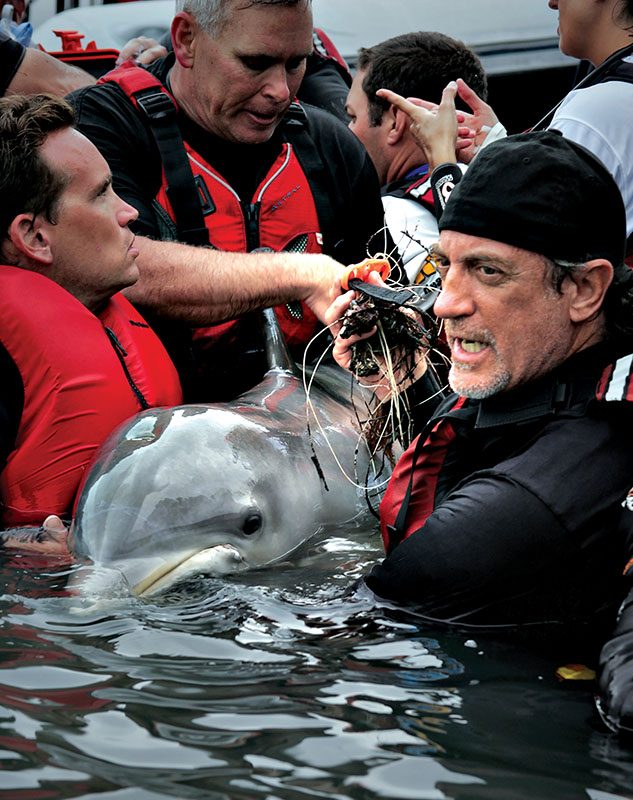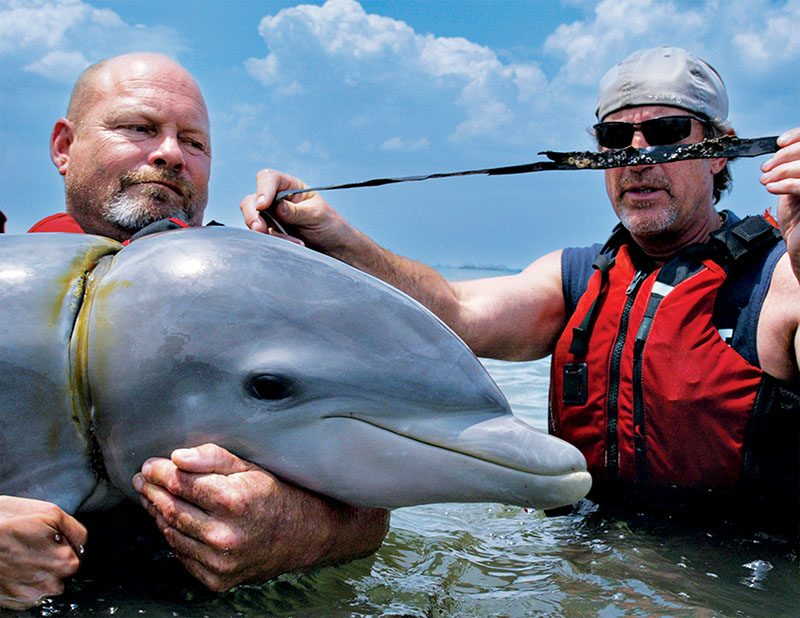An increasing global threat to marine wildlife
We’ve all seen tragic images of suffering marine animals entangled in monofilament line or other marine debris. Such images highlight the need to act, but what can we ocean advocates do to limit such harmful impacts on marine wildlife? Who responds when someone calls for help?
Working on the front lines of marine mammal rescues, I’ve been privileged to work alongside some of the best people in the most challenging circumstances, including high-risk interventions, where we safely capture at-risk marine mammals to remove entanglements and evaluate their health. It’s usually fishing gear and monofilament line, but we’ve also encountered dolphins entangled in fan belts, inner tubes, a Frisbee disc, and even a pair of underwear. We once left the safety of the cage while filming off Guadalupe Island to disentangle an 11-foot (3,3 meters) great white shark that had a plastic box band stuck around its neck.
Marine animal entanglements occur when fishing gear or marine debris becomes wrapped around an animal, weighing it down or restricting its movement. Fishing gear entanglement is a global problem that affects more than 260 aquatic species, including marine mammals, sea turtles, and seabirds.
Whether you’re a diver or a dolphin, a shark or a seabird, any entanglement can pose serious risks and become life-threatening. Our dive training helps us remain calm and signal for help, but animals often face a slow and painful death by drowning, starvation, or systemic infection.
The case of Snow Cone, a North Atlantic right whale, and her calf is a poignant example of entanglement’s long-term impacts. When she was first spotted off the Massachusetts coast in March 2021, Snow Cone already needed help. A team of trained experts were unable to remove all the gear, some of which was deeply embedded in her jaw. In December 2021, while still partially entangled, Snow Cone gave birth. Fewer than 100 breeding females remain, so this birth was cause for celebration and increased the need to quickly disentangle her.

Several gallant rescue attempts to disentangle Snow Cone all proved futile due to unsafe conditions resulting from bad weather. The last images of this leviathan mom and her still-dependent calf are from September 22, 2022, and show an emaciated Snow Cone nearly motionless at the surface and covered in sea lice. The calf gently rubbed alongside its mother, who was unable to respond or nurse her baby. According to National Oceanic and Atmospheric Administration (NOAA) Fisheries, fewer than 350 of these gentle giants remain.
The long-term effects of entanglement include deteriorating health, fatigue, decreased reproductive ability, and starvation. It can also result in deformity or amputation. One well-known entanglement story involves a dolphin named Winter, who became entangled in crab fishing pot gear in Indian River Lagoon, Florida. Winter suffered ischemic necrosis and lost her tail fluke over several months during rehabilitative care. Two films about her rescue and prosthetic tail helped increase public awareness and brought much-needed rescue resources to Florida’s Gulf Coast region and the entire state.
The International Whaling Commission estimates that globally 300,000 whales, dolphins, and porpoises die from entanglements each year, and NOAA’s National Marine Fisheries Service has identified entanglement as the leading cause of death for large whales in the U.S. The effects of fishing gear interactions are among the most pressing issues that U.S. marine mammal management agencies are currently addressing.

How do we solve the problem of entanglements, and what do we do when we witness a marine animal in distress? Public awareness is crucial, especially within the diving, boating, and ocean conservation communities. Knowing who to call is a significant part of that awareness. First, don’t take risks, and don’t push a stranded animal off the beach. Instead, immediately contact your local stranding network organization. A list of network resources is available at fisheries.noaa.gov/report. You can also report injured marine wildlife by using the Whale Alert app (iOS and Android) or NOAA’s Dolphin and Whale 911 app (iOS), or by calling NOAA’s National Enforcement Hotline at 800-853-1864.
Potential management strategies include prohibiting specific fisheries activities or imposing seasonal restrictions. Technologies such as ropeless traps or acoustic deterrents, however, may eventually mitigate entanglement impacts on marine wildlife. Ultimately, it is up to us. Public awareness campaigns directed at all marine users can focus on actions to prevent entanglement, such as using safer fishing practices and supporting ocean conservation programs like Dive Against Debris to report, reduce, and remove marine debris.
As a stranding coordinator and rehabilitation specialist for more than four decades, I’ve seen my share of entangled animals. As with any emergency, the sooner someone notifies us of an animal in distress, the better its chances of survival. Responding to entangled animals, especially enormous whales, is inherently dangerous. While many people empathize with the animals and want to help, untrained members of the public should never attempt to free entangled dolphins, whales, or manatees. The best way to help is by monitoring the animal and reporting the situation using the previously mentioned resources or to a local state wildlife agency.
For more information on marine mammal entanglements, please visit fisheries.noaa.gov/insight/entanglement-marine-life-risks-and-response. For tips on how divers can avoid becoming entangled, see scubadiving.com/9-tips-avoiding-underwater-entanglements.
© Alert Diver — Q1 2023